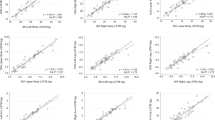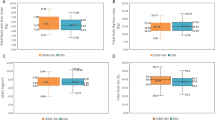Abstract
Background/Objectives
Skeletal muscle mass (SMM) estimation is important but challenging in clinical settings. Criterion methods, such as magnetic resonance imaging (MRI), are often inaccessible. However, surrogate methods, such as dual-energy X-ray absorptiometry (DXA) and multi-frequency bioelectrical impedance analysis (MFBIA), can use MRI-based equations to estimate SMM, although the agreement between these methods is unclear.
Subjects/Methods
Total and segmental SMM were estimated with DXA and MFBIA using MRI-based equations in 313 healthy adults (120 M, 193 F; age 30.2 ± 13.0 y; BMI 24.6 ± 4.0 kg/m2). DXA total SMM was estimated using the Kim and McCarthy equations, and segmental SMM was estimated using the McCarthy equations. Relationships between DXA and MFBIA SMM were examined using Deming regression, Lin’s concordance correlation coefficient (CCC), equivalence testing, Bland-Altman analysis, and related tests.
Results
Strong linear relationships were observed for total (R2 0.95, CCC 0.96–0.97), leg (R2 0.90, CCC 0.85) and arm (R2 0.93, CCC 0.93) SMM in the entire sample. Kim equation SMM demonstrated statistical equivalence with MFBIA for total SMM, but the Deming regression slope differed from 1 and proportional bias was present. McCarthy equation total SMM exhibited a regression slope that did not differ from 1, and no proportional bias was present in the entire sample. However, equivalence with MFBIA was not observed. Systematically higher leg and arm SMM values were observed with DXA as compared to MFBIA.
Conclusions
While DXA and MFBIA total SMM generally exhibited strong agreement, higher appendicular SMM by DXA highlights technical differences between methods.
This is a preview of subscription content, access via your institution
Access options
Subscribe to this journal
Receive 12 print issues and online access
$259.00 per year
only $21.58 per issue
Buy this article
- Purchase on Springer Link
- Instant access to full article PDF
Prices may be subject to local taxes which are calculated during checkout




Similar content being viewed by others
Data availability
Data may be available from corresponding author, upon reasonable request and pending relevant institutional approval.
References
Gupta P, Lanca C, Gan ATL, Soh P, Thakur S, Tao Y, et al. The association between body composition using dual energy X-ray absorptiometry and type-2 diabetes: a systematic review and meta-analysis of observational studies. Sci Rep. 2019;9:12634.
Lee DH, Keum N, Hu FB, Orav EJ, Rimm EB, Willett WC, et al. Predicted lean body mass, fat mass, and all cause and cause specific mortality in men: prospective US cohort study. BMJ. 2018;362:k2575–75.
Heymsfield SB, Adamek M, Gonzalez MC, Jia G, Thomas DM. Assessing skeletal muscle mass: historical overview and state of the art. J Cachexia Sarcopenia Muscle. 2014;5:9–18.
Wang ZM, Pierson RN Jr., Heymsfield SB. The five-level model: a new approach to organizing body-composition research. Am J Clin Nutr. 1992;56:19–28.
Erlandson M, Lorbergs A, Mathur S, Cheung A. Muscle analysis using pQCT, DXA and MRI. Eur J Radiol. 2016;85:1505–11.
Heymsfield SB, Gonzalez MC, Lu J, Jia G, Zheng J. Skeletal muscle mass and quality: evolution of modern measurement concepts in the context of sarcopenia. Proc Nutr Soc. 2015;74:355–66.
Kim J, Heshka S, Gallagher D, Kotler DP, Mayer L, Albu J, et al. Intermuscular adipose tissue-free skeletal muscle mass: estimation by dual-energy X-ray absorptiometry in adults. J Appl Physiol. 2004;97:655–60.
Bosy-Westphal A, Jensen B, Braun W, Pourhassan M, Gallagher D, Müller MJ. Quantification of whole-body and segmental skeletal muscle mass using phase-sensitive 8-electrode medical bioelectrical impedance devices. Eur J Clin Nutr. 2017;71:1061–7.
McCarthy C, Tinsley GM, Bosy-Westphal A, Müller MJ, Shepherd J, Gallagher D, et al. Total and regional appendicular skeletal muscle mass prediction from dual-energy X-ray absorptiometry body composition models. Sci Rep. 2023;13:2590.
Kim J, Wang Z, Heymsfield SB, Baumgartner RN, Gallagher D. Total-body skeletal muscle mass: estimation by a new dual-energy X-ray absorptiometry method. Am J Clin Nutr. 2002;76:378–83.
Tinsley GM, Moore ML, Benavides ML, Dellinger JR, Adamson BT. 3-Dimensional optical scanning for body composition assessment: a 4-component model comparison of four commercially available scanners. Clin Nutr. 2020;39:3160–7.
Tinsley GM, Moore ML, Graybeal AJ, Paoli A, Kim Y, Gonzales JU, et al. Time-restricted feeding plus resistance training in active females: a randomized trial. Am J Clin Nutr. 2019;110:628–40.
Tinsley GM, Harty PS, Stratton MT, Smith RW, Rodriguez C, Siedler MR. Tracking changes in body composition: comparison of methods and influence of pre-assessment standardisation. Br J Nutr. 2022;127:1656–74.
Stratton MT, Siedler MR, Harty PS, Rodriguez C, Boykin JR, Green JJ, et al. The influence of caffeinated and non-caffeinated multi-ingredient pre-workout supplements on resistance exercise performance and subjective outcomes. J Int Soc Sports Nutr. 2022;19:126–49.
Siedler MR, Rodriguez C, Stratton MT, Harty PS, Keith DS, Green JJ, et al. Assessing the reliability and cross-sectional and longitudinal validity of 15 bioelectrical impedance analysis devices. Br J Nutr. 2022:1–29. e-pub ahead of print 2022/11/21; https://doi.org/10.1017/s0007114522003749
Bosy-Westphal A, Schautz B, Later W, Kehayias JJ, Gallagher D, Muller MJ. What makes a BIA equation unique? Validity of eight-electrode multifrequency BIA to estimate body composition in a healthy adult population. Eur J Clin Nutr. 2013;67:S14–21.
Seca gmbh & co. seca 515/514 Product Manual v. 1.1: Hamburg, Germany, 2016.
Nana A, Slater GJ, Hopkins WG, Burke LM. Effects of daily activities on dual-energy X-ray absorptiometry measurements of body composition in active people. Med Sci Sports Exerc. 2012;44:180–9.
Moore ML, Benavides ML, Dellinger JR, Adamson BT, Tinsley GM. Segmental body composition evaluation by bioelectrical impedance analysis and dual-energy X-ray absorptiometry: Quantifying agreement between methods. Clin Nutr. 2020;39:2802–10.
Tinsley GM, Moore ML, Graybeal AJ. Precision of dual-energy X-ray absorptiometry reflection scans in muscular athletes. J Clin Densitom. 2020;23:647–55.
Hangartner TN, Warner S, Braillon P, Jankowski L, Shepherd J. The Official Positions of the International Society for Clinical Densitometry: acquisition of dual-energy X-ray absorptiometry body composition and considerations regarding analysis and repeatability of measures. J Clin Densitom. 2013;16:520–36.
Therneau T. deming: Deming, Theil-Sen, Passing-Bablock and Total Least Squares Regression. 2018. https://CRAN.R-project.org/package=deming
Lakens D. Equivalence tests: a practical primer for t-tests, correlations, and meta-analyses. Social Psycholog Personal Sci. 2017;8:355–62.
Bland JM, Altman DG. Statistical methods for assessing agreement between two methods of clinical measurement. Lancet. 1986;1:307–10.
Signorell A. DescTools: Tools for Descriptive Statistics. 2022. https://CRAN.R-project.org/package=DescTools
Tinsley GM, Moore ML, Rafi Z, Griffiths N, Harty PS, Stratton MT, et al. Explaining discrepancies between total and segmental DXA and BIA body composition estimates using Bayesian regression. J Clin Densitom. 2021;24:294–307.
Jiang F, Tang S, Eom JJ, Song KH, Kim H, Chung S, et al. Accuracy of estimated bioimpedance parameters with octapolar segmental bioimpedance analysis. Sensors (Basel). 2022;22:2681.
Acknowledgements
The authors wish to acknowledge the research team members and participants involved in the studies yielding the datasets used in the present analysis.
Funding
No funding was received for the present analysis. Funding for individual studies whose data were included in the analysis was provided by Texas Tech University, MTI Biotech Inc., and Legion Athletics Inc. None of these entities played any role in the present analysis.
Author information
Authors and Affiliations
Contributions
GMT and CL conceived the work. GMT, CR, and MRS contributed to data collection. GMT performed the statistical analysis. GMT and CL wrote the initial draft of the manuscript. All authors contributed to revision of the manuscript, approved the final version, and agree to be accountable for the work.
Corresponding author
Ethics declarations
Competing interests
GMT has received support for his research laboratory, in the form of research grants or equipment loan or donation, from manufacturers of body composition assessment devices, including Size Stream LLC; Naked Labs Inc.; Prism Labs Inc.; RJL Systems; MuscleSound; and Biospace, Inc. SBH reports his role on the Medical Advisory Boards of Tanita Corporation, Amgen, and Medifast. The remaining authors declare no conflicts of interest.
Ethical approval
This research was performed in accordance with the Declaration of Helsinki and was approved by the Texas Tech University Institutional Review Board (IRB2017-912, IRB2018-417, IRB2019-356, IRB2020-813, and IRB2021-107).
Informed consent
Informed consent was obtained from all participants.
Additional information
Publisher’s note Springer Nature remains neutral with regard to jurisdictional claims in published maps and institutional affiliations.
Rights and permissions
Springer Nature or its licensor (e.g. a society or other partner) holds exclusive rights to this article under a publishing agreement with the author(s) or other rightsholder(s); author self-archiving of the accepted manuscript version of this article is solely governed by the terms of such publishing agreement and applicable law.
About this article
Cite this article
Tinsley, G.M., LaValle, C., Rodriguez, C. et al. Skeletal muscle estimation using magnetic-resonance-imaging-based equations for dual-energy X-ray absorptiometry and bioelectrical impedance analysis. Eur J Clin Nutr 77, 1151–1159 (2023). https://doi.org/10.1038/s41430-023-01331-6
Received:
Revised:
Accepted:
Published:
Issue Date:
DOI: https://doi.org/10.1038/s41430-023-01331-6



